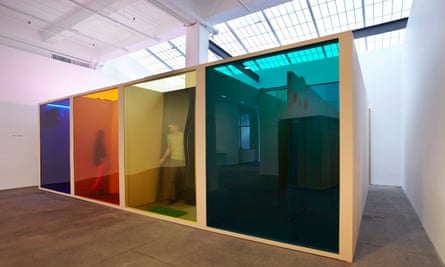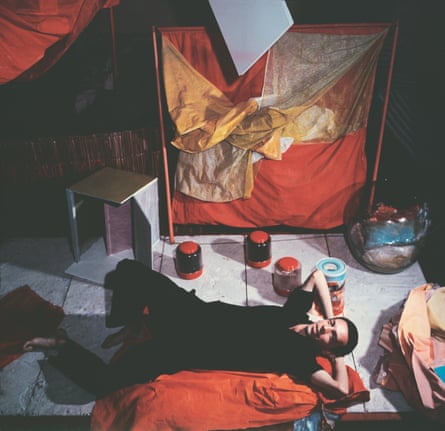In the early hours of 13 March 1973, the artist Hélio Oiticica was at his downtown New York loft, high on cocaine, with his friend, the film-maker and fellow Brazilian Neville D’Almeida. He reached for the nearest thing at hand on which to cut another line – Weasels Ripped My Flesh, an LP by Frank Zappa & the Mothers of Invention – and as he snorted, the artist noticed how the specks of powder sprayed out across the illustration of a man having his face lacerated. This transgressive interruption to what was already a violent image appealed to the pair of them, and they hit on the idea of using the drug as “paint” to deface the images of a series of similarly boundary-pushing icons of pop culture.
“We decided to transform it from cocaine to ‘white colour’. It was no longer cocaine, it was just a colour, it was like transubstantiation,” says D’Almeida, now 82, sitting in the garden of his Rio de Janeiro home.
Oiticica – who died of a stroke, aged 42, in 1980 – and D’Almeida added piles of the drug to the cover of a Marilyn Monroe biography featuring a portrait of the actor; to a newspaper profile of film-maker Luis Buñuel; and to Yoko Ono’s book Grapefruit. These were in turn photographed and projected on a huge scale in rooms filled with props and loud music. The 50th anniversary of what became the Cosmococa series – immersive installations, before that style of art was common – is now being celebrated at the De La Warr Pavilion in Bexhill-on-Sea.
Images of Jimi Hendrix adorned with a mask of cocaine will fill the modernist pavilion, and visitors will be able to listen to the guitarist’s riffs from hammocks. (While 90% of Oiticica’s work was destroyed in a fire in 2009, the artist left detailed instructions for its staging.)

The institution’s head of exhibitions Joseph Constable recognises the work could be controversial. “I’ve been thinking a lot about how people are going to respond today, when cocaine has become synonymous with hypercapitalist excess,” he says. “But for Oiticica it had a transgressive countercultural quality, and their use of it in the work was a resistance to the binds of capitalism, to patriarchy, whiteness, heteronormativity.” That Oiticica and D’Almeida were looking for mind-altering escape is understandable given the political hell that Brazil had descended into by the late 1960s – the darkest era of the military dictatorship – when Oiticica was effectively in exile in America.
At the Brazilian sculpture park Inhotim, where the Cosmococa series is on permanent display, the Monroe images flicker on and off in a gallery filled with a tarpaulin-covered sandy beach on which dozens of balloons rest. Adding to this surreal environment, the music of Peruvian singer Yma Sumac plays at ear-splitting volume. To view the Ono images, one navigates a gallery of moveable fabric-covered foam, balls, cubes and cones while her music plays. Wandering this psychedelic maze is a strange experience. It is lo-fi compared to the kind of immersive art experiences audiences are now used to, but nonetheless disorientating and occasionally claustrophobic. “We were two skinny, starving Brazilians but we wanted to do something that had never been done before,” D’Almeida says.
Initially they only dared exhibit the work in Oiticica’s apartment to invited friends, including homeless people and young men that Oiticica would pick up on the street. It was an “experimental exercise of freedom”, the critic Mario Pedrosa, a contemporary of Oiticica wrote. “The reaction was terrible,” D’Almedia says. “Everybody hated it, everybody was pointing their fingers at us because we used cocaine at work, there was so much false morality around. It took 20 years for it to be shown in a gallery.”

Oiticica was born to a middle-class bohemian family in Rio de Janeiro in 1937. His father was a photographer; his grandfather had been a committed anarchist. At art college he joined Grupo Frente, an artist movement founded by his teacher Ivan Serpa, alongside Lygia Clark and Lygia Pape, who would similarly become icons of Brazilian art. Oiticica’s geometric abstract paintings were strong in primary colours, but he soon found the medium limiting and by the 1960s he and Clark were experimenting with performance and interactive sculpture. “The objective is to give the public the chance to stop being a spectator, from the outside, and become a participant in the creative activity,” the artist wrote.
To this end, Parangolés was a series of complex multifaceted capes, inspired by carnival, which the public could wear as part of happenings he staged in Rio’s favelas and as part of the samba school he joined. The project, he said, served “a vital need for de-intellectualization, intellectual disinhibition, the need for free expression” in art. Later, artist Carlos Zilio put it more succinctly: “The samba conquers the sacrosanct ‘museum’, and the ‘museum’ goes down to the samba court”. He took the capes to New York too, persuading passengers on the subway to try them on. At Bexhill, recreated versions of the originals will be on show, a move Constable feels is truer to the original ethos of the work. “He was never comfortable with the white cube, he always set about transforming it, resisting the white walls. Museums are intrinsically about preservation. If we showed the originals they would have to be secured behind glass and no one could touch them. It would destroy the performativity of their intention.” Instead, visitors will be able to try them on.
after newsletter promotion

The artist’s stay in the US was enabled by a fellowship he received in 1970, but the timing was fortuitous as Brazil was becoming too dangerous for him. Two years prior, Caetano Veloso and Gilberto Gil, with whom Oiticica had spearheaded the Tropicália movement, had been arrested for performing with a flag hung by the artist on their stage. Revolutionary red, it featured the slain body of Manuel Moreira, a favelado known as Horse Face – the first victim of a clandestine group of police officers acting extrajudicially to eliminate criminals, trans people and homeless people. Underneath, Oiticica had printed “be an outlaw, be a hero”. After their release nine months later, both musicians fled to London.
“I have always liked what is forbidden, the life of trickery, which represents the adventure of people who live intensely and immediately because they take risks. These people are so smart. Much of my life has been spent visiting my friends in prison,” Oiticica wrote, but he knew that he didn’t want to join them.
It was the law, though, that forced his eventual return to Brazil in 1978. The New York loft had become an overwhelming art project in itself, Oiticica having built a series of “nests”, as he called them: fabric and wood structures in which he could hide with and from the constant parade of people passing through. While initially working as a translator, with his visa long maxed out and with an aversion to New York’s commercial art world, he turned to drug dealing. One day the doorbell rang and Oiticica, leaning out the window two storeys up, looked down to see a couple of FBI agents staring up at him. A friend of his – a model for Pierre Cardin – had been caught smuggling drugs through John F Kennedy Airport. Did Oiticicia know anything about it? As the cops climbed the stairs, he managed to hide his drugs amid the maze of art installations that now consumed the space. It was a close call but one, with the repression back home lessening, that spurred his return to Brazil, and to get clean.
-
Hélio Oiticica: Waiting for the Internal Sun is at De La Warr Pavilion, Bexhill, from 23 September to 14 January
